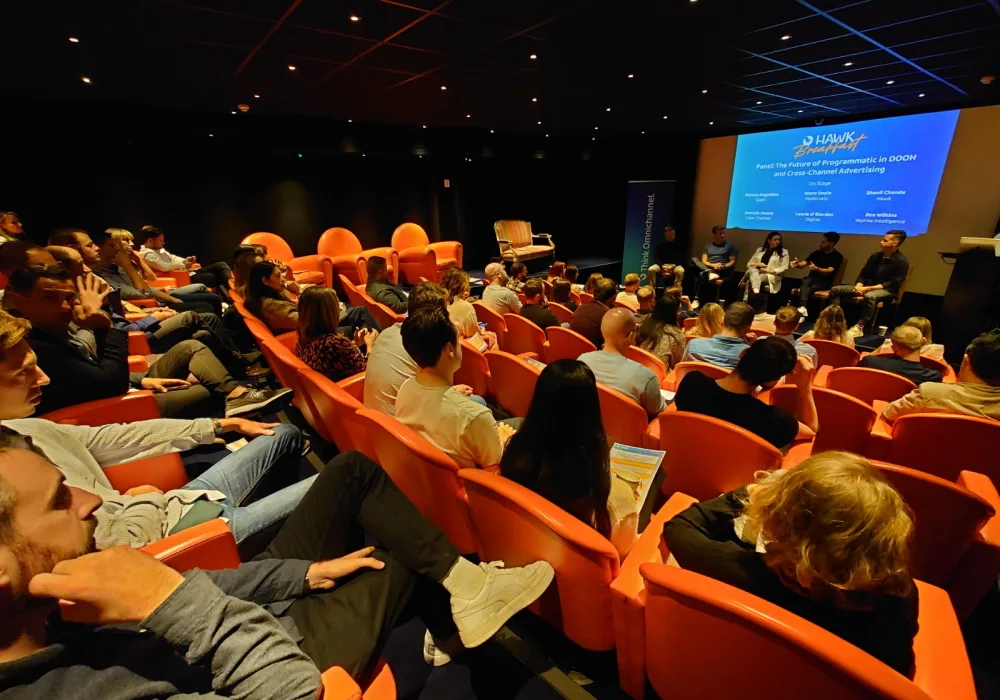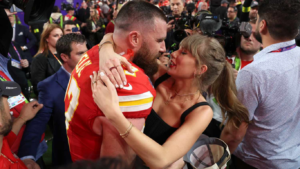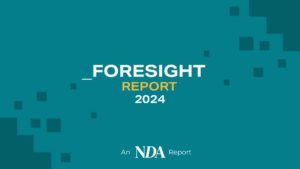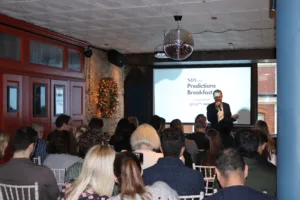By Chris Childs, Managing Director UK, Hawk Platform
Just over two years ago, pandemic induced lockdowns emptied the UK’s streets. It was a bleak time for many industries, not least the out-of-home (OOH) advertising sector, with screens deprived of their usual footfall.
We continue to face uncertain times, but the billboard bounce-back cannot be denied; digital out-of-home (DOOH) revenues for Q1 2022 were 84% of pre-pandemic levels according to OOH trade body, Outsmart. The viability of DOOH has been driven by programmatic – even during lockdown it enabled the messaging of public health campaigns to be tailored to specific times, regions and postcodes.
It was a fitting time therefore to launch Hawk Platform’s series of quarterly industry get-togethers with an (in person!) event at the Charlotte Street Hotel to discuss programmatic’s role in fuelling the regrowth of DOOH advertising.
Hawk’s Publisher Partnerships Manager Henry Taylor led with the observation that some speculations about future society depicted in TV and film stay with us – notably here the personalised and interactive billboards in Minority Report, made twenty years ago.
He went on to note that in 2022 the strength of the channel is clear; Group M’s Kantar found DOOH is now ranked with TV and radio as one of the most entertaining ad mediums, and VIOOH reported that over 89% of UK advertising executives are planning to incorporate programmatic DOOH into their multi-channel buys this year – while TikTok is turning to OOH to engage new consumers.
With the scene set, we moved on to our expert panel discussions, moderated by Steve Doyle.
The Rise of Programmatic in DOOH was discussed by James Trott from Matterkind, Kate Tovey from JCDecaux, Mungo Knott from Global, Joseph Lee from Rommatic, and Luise Weiss from AdSquare.
The second session, The Future of Programmatic in DOOH and Cross-Channel Advertising, was covered by Marcos Angelides from Spark, Dominic Dunne from Clear Channel, Laurie O’Riordan at Digitas, Ben Wilkins from Skyrise Intelligence, and Shanil Chande from Hawk.
Topics covered were wide-ranging, but some key themes emerged.
Data and technology
Data and the increasing granularity of data sets that show actual audience behaviour is causing the space to change rapidly and is a key factor in outdoor’s recovery. Combined with technology it is enabling advertisers to achieve previously impossible outcomes in terms of reaching a specific audience, speaking to them with a particular creative, and measuring the impact of a campaign. The ability to curate particular audience segments and reach them at relevant times means DOOH can be effective further down the sales funnel than has traditionally been feasible.
Programmatic DOOH technology has not (yet) achieved the fluidity of traditional programmatic (an unfair expectation); merely adding new inventory to a 10-year-old technology stack isn’t the right solution.
Context and creativity
DOOH briefs increasingly feature personalised copy as programmatic’s contextual capability is recognised – it enables an ad to be changed so that either its content, or where and when it appears, is highly likely to resonate with the viewer.
Programmatic has a clear role when using data to drive efficiency, but it is not always the best fit. And for all data’s importance, creativity should always take the lead. Neither should data be allowed to over-complicate or ‘over target’ a campaign; sometimes simple is better – a digital outdoor screen showing the pollen count for a particular area for example is a relevant and useful message for all hay fever sufferers in the region without further segmentation.
Measurement
Measurement is a strategic decision driven by client and campaign objectives. One brand might want to be very tactical about the specific locations of the ad and how often it appears, whereas another might be solely focused on muscling out the competition.
Additional detail was provided by Mo Moubayed, co-founder and co-CEO at Veridooh, an Australian start-up (now launched in the UK) offering independent verification for OOH advertising. The initial idea for the company was a DOOH network, but agencies hearing the proposition voiced concerns about how they would know whether their ad had played – and the concept for Veridooh was born.
Ad fraud
Brand safety is a very different consideration in the outdoor arena, tending to focus on issues such as ensuring alcohol ads don’t appear too near a school for example. The point was emphasised that much rigour, including regular audits, is applied to this advertising channel, with the contractual, reputational and financial stakes too big to risk non-compliance. The overall conclusion? “Fraud is not a big conversation in this space.”
The agency role and structure
Agencies are critical to the future evolution of DOOH to ensure it delivers for clients. Linking this to agency structure, while it needs to be recognised that outdoor plays a very different role to other channels, programmatic and out-of-home teams need to be blended if brands are to get the best from data and automation.
This is happening, and often more quickly than expected. However, planning and activation still need to come closer together and, to realise the opportunity to integrate planning, measurement, investment, insight and strategy, all teams should be engaged with the technology.
The future of OOH is data-driven and measurable
Programmatic DOOH introduces a new member to the programmatic family, with data tying together the different channels to enable omni-channel, and with that, multiple connected consumer touchpoints. However, it is important to keep in sight that digital out-of-home, with its broadcast and one-to-many capabilities, is very different from other digital channels, and the roles of each need to be understood.
There is a genuine passion for the space, which offers opportunities for new collaborations, while learning from the programmatic journey so far.
Programmatic DOOH means we say goodbye to the days of buying posters for a minimum period of one month, ushering in instead the ability to be flexible and dynamic. At the same time, we can maintain a critical outdoor attribute – in providing a platform that is suited for such a broad range of brands, outdoor talks to everyone.









